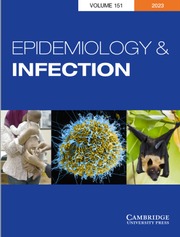Crossref Citations
This article has been cited by the following publications. This list is generated based on data provided by
Crossref.
Elford, William J.
and
Ende, Joan Van Den
1945.
Studies on the disinfecting action of hypochlorous acid gas and sprayed solution of hypochlorite against bacterial aerosols.
Journal of Hygiene,
Vol. 44,
Issue. 1,
p.
1.
Ewell, Arthur W.
1946.
Recent Ozone Investigations.
Journal of Applied Physics,
Vol. 17,
Issue. 11,
p.
908.
Warshaw, Leon J.
1953.
Bactericidal and Fungicidal Effects of Ozone on Deliberately Contaminated 3-D Viewers.
American Journal of Public Health and the Nations Health,
Vol. 43,
Issue. 12,
p.
1558.
INGRAM, M.
and
BARNES, ELLA M.
1954.
STERILIZATION BY MEANS OF OZONE.
Journal of Applied Bacteriology,
Vol. 17,
Issue. 2,
p.
246.
Houwink, E. H.
and
Rolvink, W.
1957.
The quantitative assay of bacterial aerosols by electrostatic precipitation.
Epidemiology and Infection,
Vol. 55,
Issue. 4,
p.
544.
Meyers, Charles E.
James, Howard A.
and
Zippin, Calvin
1961.
The Recovery of Aerosolized Bacteria from Humans.
Archives of Environmental Health: An International Journal,
Vol. 2,
Issue. 4,
p.
384.
Morris, E. J.
Darlow, H. M.
Peel, J. F. H.
and
Wright, W. C.
1961.
The quantitative assay of mono-dispersed aerosols of bacteria and bacteriophage by electrostatic precipitation.
Epidemiology and Infection,
Vol. 59,
Issue. 4,
p.
487.
Raiß, Wilhelm
and
Roedler, F.
1963.
H. Rietschels Lehrbuch der Heiz- und Lüftungstechnik.
p.
284.
Sachsenmaier, Wilhelm
Siebs, Wilhelmine
and
Tan, Tjong-An
1965.
Wirkung von Ozon auf M�useascitestumorzellen und auf H�hnerfibroblasten in der Gewebekultur.
Zeitschrift f�r Krebsforschung,
Vol. 67,
Issue. 2,
p.
113.
Stokinger, H. E.
1965.
Ozone Toxicology.
Archives of Environmental Health: An International Journal,
Vol. 10,
Issue. 5,
p.
719.
Jaffe, L S
1967.
The biological effects of photochemical air pollutants on man and animals..
American Journal of Public Health and the Nations Health,
Vol. 57,
Issue. 8,
p.
1269.
Stokinger, Herbert E.
and
Coffin, David L.
1968.
Air Pollution and its Effects.
p.
445.
BAIRD-PARKER, A.C.
and
HOLBROOK, R.
1971.
Inhibition and Destruction of the Microbial Cell.
p.
369.
Bruck, Stephen D.
1971.
Sterilization problems of synthetic biocompatible materials.
Journal of Biomedical Materials Research,
Vol. 5,
Issue. 3,
p.
139.
HOFFMAN, R.K.
1971.
Inhibition and Destruction of the Microbial Cell.
p.
225.
Rappolt, Richard T.
1972.
The Ozone Generator.
Clinical Toxicology,
Vol. 5,
Issue. 3,
p.
419.
Lighthart, Bruce
1973.
Survival of Airborne Bacteria in a High Urban Concentration of Carbon Monoxide.
Applied Microbiology,
Vol. 25,
Issue. 1,
p.
86.
Babich, Harvey
and
Lighthart, Bruce
1974.
Air pollution and microbial ecology.
C R C Critical Reviews in Environmental Control,
Vol. 4,
Issue. 1-4,
p.
353.
Pelleu, George B.
Berry, Ronald F.
and
Holleman, Nathan G.
1974.
Ozone and Glycol Vapor Decontamination of Air in a Closed Room.
Journal of Dental Research,
Vol. 53,
Issue. 5,
p.
1132.
Treshow, Michael
1975.
Responses of Plants to Air Pollution.
p.
307.

